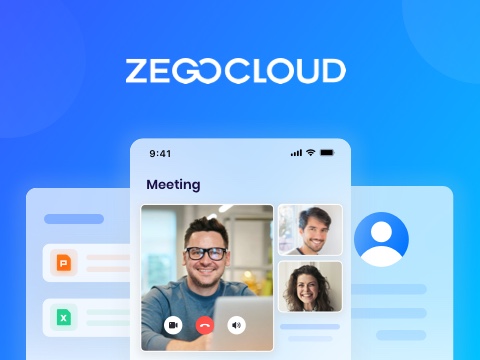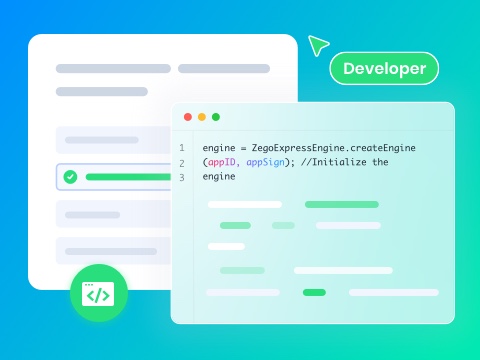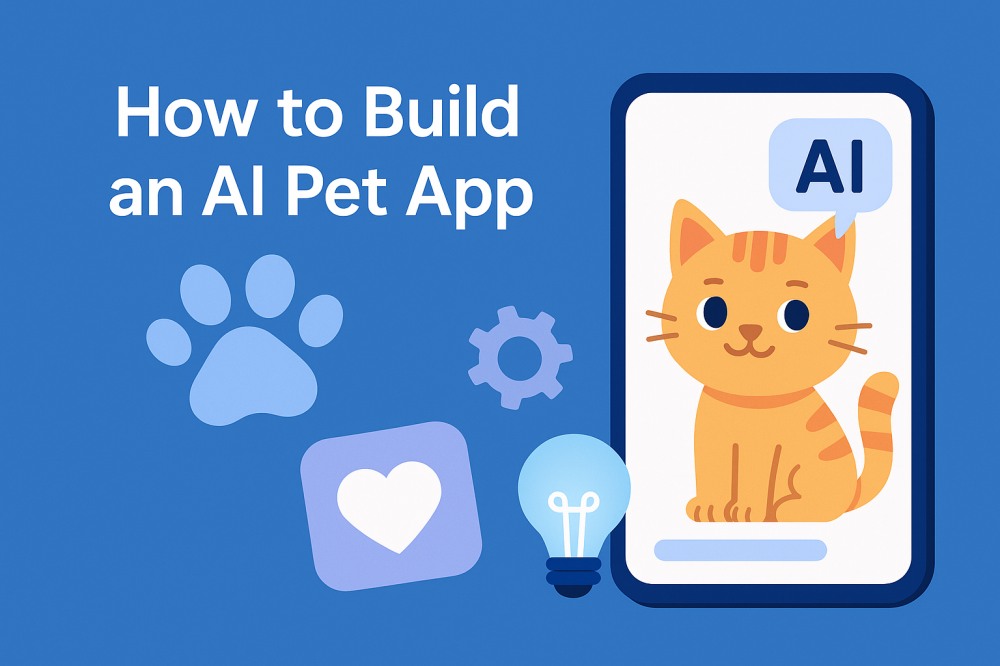You want a profound sense of peace from pets, but a hectic routine comes in the way? What if you create a virtual companion that learns, plays, and interacts just like a real pet? Hence, this will blend fun, creativity, and technology, where you can personalize interactions and entertainment anytime. So, if you want to make an AI pet app for yourself or introverts, this guide is for you.
What is an AI Pet App?
An AI pet app is a program that uses artificial intelligence to create digital pets. Additionally, an AI pet desktop app or a mobile app provides users with an interactive experience for expressing emotions to their virtual companions. Besides, some apps can track a virtual pet’s activity, eating, and sleep habits through built-in simulated systems. With this, users can stay alert to in-app behavioral changes and respond through care actions.
Furthermore, an AI pet app gives advice on nutrition, training, and general well-being based on each virtual pet’s profile. Developers can also offer fun learning tools, reminders, and AR features to help players play and train their pets. In addition, one can even leverage AI chatbots to answer questions instantly and easily access information about caring for their digital pet.
Why Invest in AI Pet App Development?
To make AI pet-to-human interaction smooth and convenient, virtual pet apps are playing a key role. However, beginner developers often question why they should invest in these apps. Thus, we have gathered some market insights to help you determine its hype:
- Massive and Growing Pet Market: The virtual pet applications market is expanding at a rapid rate and may hit above 4 billion in 2033. Therefore, children and adults have fun emotionally, through entertainment, and by interacting digitally. This is why virtual pets are a lucrative and sustainable market.
- Emotional Bonding & User Engagement: AI pets provide powerful emotional bonds with their user since they give personalized experiences, respond to the behaviors of the users, and promote well-being. Therefore, this will keep users active and visiting it daily, and make the apps look like real companions.
- Innovative Features Drive Monetization: The app has customization, subscriptions, premium services, and in-app purchases, as well as AI pet companions that can learn, adapt, and develop an individual personality. The gamified routines, events, and collectibles also add more user value as time goes by.
- Accessible & Inclusive User Base: AI pet apps appeal to kids, adults, and seniors, and voice and language features make them easy to use. Thus, the app works on mobile and other devices and makes it accessible to users in various regions, including those in emerging digital markets.
- Technological Differentiation & Competitive Edge: AI and AR features create realistic, context-aware experiences that stand out from casual games. So, investing in these apps attracts tech-focused users and builds a strong competitive brand presence.
Benefits of Developing an AI Pet App
Do you know that talking pets AI can create a strong bond between users and their virtual companions? So, if you want to know where else they can benefit you, review the listed perks:
| Benefit | Description | Why It Matters |
|---|---|---|
| Emotional Connection | AI pets respond with simulated personality, emotions, and behavior patterns. | Builds loyalty, frequent interaction, and a stronger bond with users. |
| Personalized Virtual Care | Suggests in-app routines, activities, and guidance based on the virtual pet’s profile. | Makes the experience feel tailored and keeps users engaged in caring for their digital pet. |
| Entertainment & Engagement | Provides games, mini-challenges, and interactive routines. | Keeps users returning and boosts app retention. |
| Monetization Opportunities | Offers subscriptions, premium features, in-app purchases, and collectibles. | Generates recurring revenue and increases user lifetime value. |
| Accessible to All Users | Designed for kids, adults, and seniors with cross-platform support. | Expands the audience globally and increases adoption. |
| Competitive Advantage | Uses AI, AR, and interactive features to enhance the digital pet experience. | Differentiates the app from basic pet games and appeals to tech-savvy users. |
| Wellness & Education | Encourages routine-building, responsibility, and playful learning. | Positions the app as both entertaining and developmentally meaningful. |
| Scalable & Future-Ready | Designed to support future updates and integration with new technologies. | Ensures long-term relevance as the app evolves. |
Types of AI Virtual Pet Apps
Whether you want to make an AI pet dog or a cat app, know that there are many types of virtual pet apps. So, to help you determine your target virtual pet app for development, adhere to the given types and examples.
1. Classic Virtual Pet Simulators
These applications allow their users to adopt, feed, groom, and even play with a virtual pet, which may be My Boo, Bubbu, Moy, or Dogotchi. Therefore, pets feel emotions and seek attention and rewards, or accessories are unlocked by caring and interacting with pets. Additionally, it is concentrated on the everyday care and mini-games in which experience is enjoyable and amusing.
2. Talking/Conversational AI Pets
Apps like Talking Tom or My Talking Angela use AI to recognize voice and text. Thus, pets repeat words, respond to speech, and hold simple conversations. So, this creates an interactive experience where the digital pet feels alive and full of personality. It also encourages users to return daily and build a stronger bond with their virtual companion.
3. AR/3D Virtual Pet Experiences
These apps use augmented reality or advanced 3D graphics, like My Cat or Hellopet. Using these AI pets for adults and kids, users can see them in the real world, on a desk or a floor, and take care of them. Hence, it makes the experience more realistic and immersive and adds fun and excitement by blending virtual pets with the real environment.
4. Social & Collaborative Virtual Pet Apps
Apps like Pengu allow friends or family to share control of a pet. Hence, users feed, play, and customize pets together, turning the app into a social activity that builds bonds. It also encourages teamwork and friendly competition. So, it makes the experience more engaging for everyone involved.
5. Simulated Animal Role-Play
Some apps let users take on the role of a pet and experience life from the animal’s perspective. Games such as Cat Sim Online also give a person an opportunity to live in the life of an animal, accomplish missions, and communicate with other virtual animals. Therefore, these properties bring in some sense of adventure to the gameplay process and give one an in-depth insight into the behavior of animals.
Must-Have Features of an AI Virtual Pet App
When you are designing AI for pet applications, there are bundles of features you can add to make it stand out. However, too many features can baffle the consumers; have a quick review of the main ones.
| Feature | Description | User Benefit |
|---|---|---|
| Pet Care Activities | Feeding, grooming, interactive play, cleaning, and training with reminders. | Encourages regular interaction and supports consistent in-app routines. |
| Emotional Simulation | The pet displays simulated emotions and reacts to user actions. | Builds emotional connection and makes the virtual pet feel more engaging. |
| Voice/Text Interactivity | Users talk or write to pets; the system provides AI-based or scripted responses. | Creates an interactive, personality-driven experience. |
| Customization Options | Personalize pet appearance, accessories, home, and traits. | Enhances ownership experience and creativity. |
| Progression & Rewards | Level system, collectibles, achievements, mini-games, and evolving traits. | Motivates continued use and increases user retention. |
| Health & Status Tracking | Dashboard with updates on virtual health, mood, feeding, and activity. | Helps users monitor their virtual pet’s well-being effectively. |
| Social & Multiplayer | Shared ownership, gifting, co-parenting, and social gaming. | Encourages collaboration, bonding, and friendly competition. |
| Reminders & Notifications | Alerts for feeding, sleep, play, and check-ins. | Maintains routine and keeps users engaged. |
| Safe & Friendly UI/UX | Intuitive, visually appealing, secure interface for all ages. | Provides easy access and safety for young users. |
| AR/3D Visualization | Augmented reality or immersive 3D graphics. | Creates lifelike interaction and deeper immersion. |
How to Develop an AI Virtual Pet App
Know that creating an AI pet app requires a structured and iterative process that combines design and core pet care features. Thus, if you need guidance, this section will highlight how to create an application in a few steps:
1. Market Research and Concept
Start by studying your target users, their age, location, and preferences. Also, identify popular features in top virtual pet apps and note user complaints and positive feedback. Use this research to define your app’s core idea, including design style, emotional appeal, and AI goals.
2. Feature Planning and Prototypes
After that, create app sketches and mock-ups with essential features such as pet care. Moreover, add emotion display, voice or text chat, customization, AR/3D graphics, health tracking, and rewards. Also, plan the pet’s behavior, reactions, and growth to ensure a smooth user experience from adoption to daily care.
3. AI Technology and Infrastructure
Select AI tools for chat, emotion detection, personalization, and behavior logic. Additionally, add machine learning for voice/text recognition and user adaptation. In the process, you can use tools such as ZEGOCLOUD to chat in real time or play in groups to facilitate real-time interaction. It is a real-time communication platform that gives developers the APIs to add live audio, video, and messaging functionalities to their apps.
In addition, the developers can add low-latency streaming to synchronous interactions, AI-based moderation tools, and iOS, Android, and web advanced SDKs. Moreover, it embraces multiplayer teamwork, personalized notifications, and expandable cloud computing. Users can also integrate the AI Agent SDK to create chatbots that assist, answer questions, and guide users within the app to care for their AI pet.
4. Development and Integration
Furthermore, develop the app in cycles with small tests and feedback. Build an easy-to-use front-end and connect it to secure backend servers for data and profiles. Also, integrate ZEGOCLOUD SDKs for real-time chat, notifications, and shared pet care.
5. Testing and Launch
As everything is set, check the app for performance, security, and a smooth user experience. Additionally, test AI pet behavior on different devices and ensure chat or multiplayer features work well. Moreover, release a beta version, collect feedback, refine the app, and launch on iOS and Android with a focus on unique AI and multiplayer features.
6. Updates and Support
After launch, track user engagement and revenue to add new customization options, AR content, mini-games, and seasonal updates. Additionally, respond to user requests and fix issues quickly so they don’t lose interest in the app. Also, use scalable infrastructure like ZEGOCLOUD to support growth and maintain a seamless virtual pet experience.
The Cost of Building an AI Virtual Pet App
To make AI pet companions, do you know how much it will actually cost you, since it’s an essential aspect in development? So, to offer you a rough estimate, review the given table and determine how to manage it:
| Cost Component | Estimated Range |
|---|---|
| App Design & UX/UI | $5,000 – $20,000 |
| AI & Machine Learning Integration | $15,000 – $50,000+ |
| AR/3D Graphics & Animation | $10,000 – $40,000 |
| Backend & Database | $8,000 – $25,000 |
| Mobile Development (iOS & Android) | $20,000 – $60,000 |
| Social & Multiplayer Features | $5,000 – $15,000 |
| Notifications & Reminders | $2,000 – $5,000 |
| Testing & Quality Assurance | $3,000 – $10,000 |
| Marketing & Launch | $5,000 – $25,000+ |
| Maintenance & Updates | $2,000 – $10,000 annually |
How to Monetize an AI Pet App
Once you create AI pets for adults and kids, you must focus on their monetization to generate revenue. Therefore, here we have shared some common and effective strategies that you can easily follow:
- In-App Purchases (Micro Transactions): Customers can purchase virtual items like pet outfits, accessories, toys, foods, special animations, or power-ups. Therefore, the most effective personalization is when users develop feelings towards their pets.
- Subscriptions: This can be in the form of monthly or annual subscriptions, whereby they unlock upgraded AI behaviors, premium pet breeds, special care routines, no advertisements, or health insights. Therefore, the subscriptions mean a consistent fee and stimulate long-term use.
- Brand Partnerships and Sponsored Content: Find brands, toy companies, or animal wellness providers to feature branded products, seasonal events, or co-branded accessories. Therefore, the app makes money on sponsorship and events, as well as affiliate deals, and brands expose themselves to active pet-loving audiences.
- Advertising (Native & Contextual Ads): Place pertinent advertisements of pet products, classes, or services. Afterward, allow customers to get rid of advertisements through purchase or subscription. Grooming promotions like post-pet care, virtual pets, and contextual advertising can also be incorporated into the functionality of the application to bring income without annoying the user.
- E-commerce and Physical Goods Integration: Have an in-app store with actual pet products such as food, toys, outfits, and supplements. It enables customers to make orders on behalf of their pets using the application.
Best Practices to Develop an AI Pet Companion App
When you develop talking pets AI applications, following the basic regulations and guidelines can help in proper scaling. Therefore, this section highlights some practices that you must follow while making a virtual pet app:
- User-Centered Design and Accessibility: Begin by understanding user needs, age groups, and interaction preferences. Also, develop simple, attractive, and accessible interfaces for children, adults, and seniors. Aim to create an emotionally engaging experience and test different layouts with real users to ensure ease of use.
- Scalability and Real-Time Performance: Build an architecture that supports a growing user base and upcoming features. Use scalable cloud infrastructure and modular backend systems, and include real-time interaction only if the app requires multiplayer or synchronous features.
- Responsible AI Integration: Choose AI models for pet behavior simulation and voice/text interaction. Set boundaries to ensure predictable and safe responses, and monitor AI outputs for consistency. Also, provide users with clear explanations of data usage to maintain transparency and trust.
- Dynamic Content and Evolving Pet Behavior: Create pets that evolve and become more engaging over time, and introduce new content, behaviors, mini-games, and events. In addition, add rewards and achievements, and refine pet traits to create a sense of progress and attachment.
- Continuous Testing and Improvement: Carry out comprehensive QA tests on the devices, which include functional, security, and performance tests. Besides, gather user feedback, track bugs, and measure user retention and satisfaction to guide ongoing improvements.
Conclusion
To wrap up, if you want to create an AI pet app, this guide has offered a detailed roadmap to build a compelling and entertaining companion. From understanding what features to add to determining the overall cost, review all details. However, for real-time chat or multiplayer features with ultra-low latency, usage of ZEGOCLOUD is suggested.
FAQ
Q1: What exactly is an AI pet, and how does it work?
An AI pet is a virtual character that can understand user input, learn preferences, recognize emotions, and respond in a human-like way using technologies such as NLP, speech recognition, TTS, and behavior-generation models. It works by combining a real-time interaction engine with a memory system that allows the pet to evolve over time.
Q2: What platform is best for building an AI pet: iOS, Android, or Web?
Most developers build cross-platform apps with Flutter or React Native so they can reach both iOS and Android users. Web versions are also popular but may not support advanced voice or animation features as smoothly as mobile apps.
Q3: How much does it cost to run an AI pet app?
Costs depend on LLM usage, voice processing, and real-time audio/video traffic. Apps that use heavy voice interaction may spend more because STT and TTS are used continuously. Keeping conversations short, using caching, or choosing a cost-effective RTC provider can reduce expenses significantly.
Let’s Build APP Together
Start building with real-time video, voice & chat SDK for apps today!










